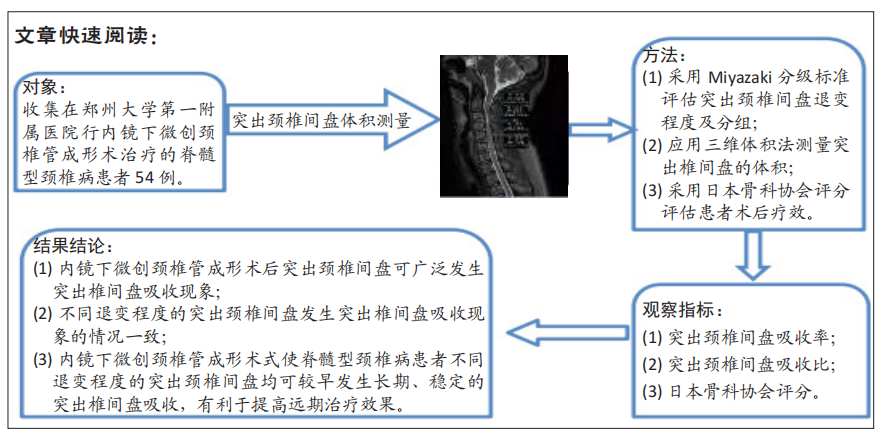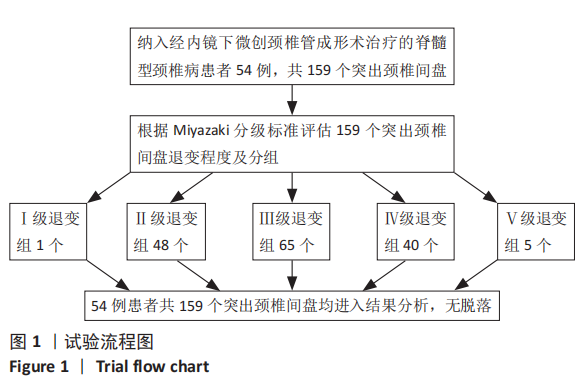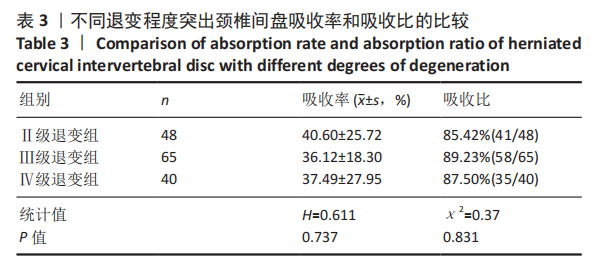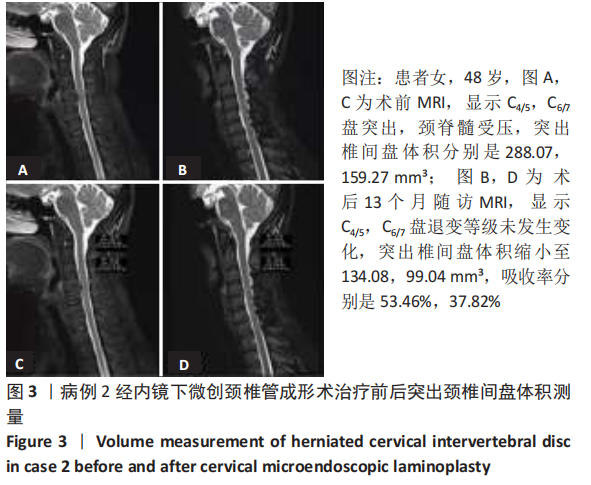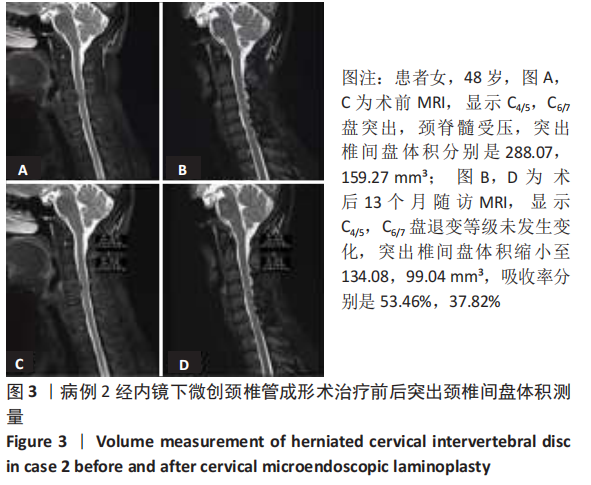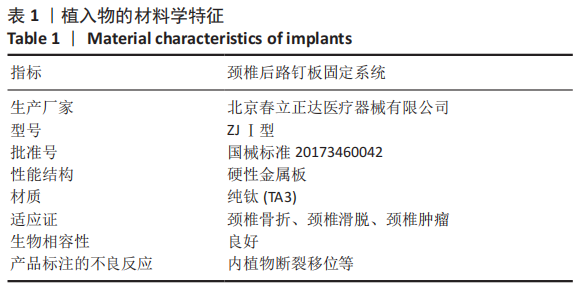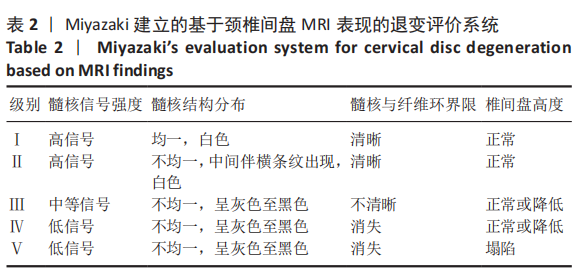[1] 潘敏,吴毅文.脊髓型颈椎病344例临床特征分析[J].中国临床康复, 2005,9(38):78-80.
[2] 陈雄生,贾连顺,袁文,等.脊髓型颈椎病自然史规律研究[J].中国矫形外科杂志,2002,10(13):1301-1304.
[3] MCCORMICK JR, SAMA AJ, SCHILLER NC, et al. Cervical Spondylotic Myelopathy: A Guide to Diagnosis and Management. J Am Board Fam Med. 2020;33:303-313.
[4] LEBL DR, BONO CM. Update on the Diagnosis and Management of Cervical Spondylotic Myelopathy. J Am Acad Orthop Surg. 2015;23:648-660.
[5] PASSIAS PG, MARASCALCHI BJ, BONIELLO AJ. Cervical spondylotic myelopathy: National trends in the treatment and peri-operative outcomes over 10years. J Clin Neurosci. 2017;42:75.
[6] 贾连顺,史建刚.重视脊髓型颈椎病的诊断与严格手术指征[J].中华骨科杂志,2002,22(1):57-59.
[7] 侯增涛,赵爱琳,郭传友,等.多节段脊髓型颈椎病治疗方式选择与疗效评价[J].中国组织工程研究,2014,18(40):6444-6450.
[8] ZHANG C, LI D, WANG C, et al. Cervical Endoscopic Laminoplasty for Cervical Myelopathy. Spine (Phila Pa 1976). 2016;41 Suppl 19:B44-B51.
[9] 张春霖,张银鹤,严旭,等.内镜下颈椎管成形术治疗脊髓型颈椎病[J].中华骨科杂志,2017,37(2):89-95.
[10] 张春霖,刘洋,尚利杰,等.基于PACS软件定量体积测量“监控”的突出颈椎间盘体积观察[J].中国组织工程研究,2020,24(18): 2888-2892.
[11] 吴彦禹,张春霖,邵成龙,等.二维距离法和三维体积法对内镜下微创颈椎管成形后突出椎间盘再吸收的定量测量[J].中国组织工程研究,2021,25(21):3390-3394.
[12] 李莹,王永魁,尚利杰,等.颈后路微创椎管扩大成形术对颈椎间盘退变的影响[J].郑州大学学报(医学版),2020,55(2):278-281.
[13] 李莹,李龙,严旭,等.内镜下微创颈椎管成形术”诱导”突出颈椎间盘自然吸收的初步观察[J].中国实用医刊,2020,47(10):15-19.
[14] MOCHIDA K, KOMORI H, OKAWA A, et al. Regression of cervical disc herniation observed on magnetic resonance images. Spine (Phila Pa 1976). 1998;23(9):990-995.
[15] AUTIO RA, KARPPINEN J, NIINIMAKI J, et al. Determinants of spontaneous resorption of intervertebral disc herniations. Spine(Phila Pa 1976). 2006;31(11):1247-1252.
[16] MIYAZAKI M, HONG SW, YOON SH, et al. Reliability of a magnetic resonance imaging-based grading system for cervical intervertebral disc degeneration. J Spinal Disord Tech. 2008;21(4):288-292.
[17] NAKASHIMA H, YUKAWA Y, SUDA K, et al. Cervical Disc Protrusion Correlates With the Severity of Cervical Disc Degeneration: A Cross-Sectional Study of 1211 Relatively Healthy Volunteers. Spine (Phila Pa 1976). 2015;40(13):E774-779.
[18] TAKASHIMA H, TAKEBAYASHI T, YOSHIMOTO M, et al. Correlation between T2 relaxation time and intervertebral disk degeneration. Skeletal Radiol. 2012;41:163-167.
[19] MIYAZAKI M, HONG SW, YOON SH, et al. Kinematic analysis of the relationship between the grade of disc degeneration and motion unit of the cervical spine. Spine (Phila Pa 1976). 2008;33(2):187-193.
[20] HENMI T, SAIRYO K, NAKANO S, et al. Natural history of extruded lumbar intervertebral disc herniation. J Med Invest. 2002;49(1-2):40-43.
[21] HARO H, KATO T, KOMORI H, et al. Vascular Endothelial Growth Factor (VEGF)-induced Angiogenesis in Herniated Disc Resorption. J Orthop Res. 2002;20(3):409.
[22] GEISS A, SOBOTTKE R, DELANK KS, et al.Plasmacytoid dendritic cells and memory T cells infiltrate true sequestrations stronger than subligamentous sequestrations: evidence from flow cytometric analysis of disc infiltrates. Eur Spine J. 2016;25(5):1417-1427.
[23] TSURU M, NAGATA K, UENO T, et al.Electron microscopic observation of established chondrocytes derived from human intervertebral disc hernia (KTN-1) and role of macrophages in spontaneous regression of degenerated tissues. Spine J. 2001;1(6):422-431.
[24] ZHU Y, LIU JT, YANG LY, et al. p38 mitogen-activated protein kinase inhibition modulates nucleus pulposus cell apoptosis in spontaneous resorption of herniated intervertebral discs: An experimental study in rats. Mol Med Rep. 2016;13(5):4001-4006.
[25] HARO H, KOMORI H, KATO T, et al. Experimental studies on the effects of recombinant human matrix metalloproteinases on herniated disc tissues--how to facilitate the natural resorption process of herniated discs. J Orthop Res. 2005;23(2):412-419.
[26] 张天宏,彭笳宸,李青,等.突出的椎间盘组织中巨噬细胞浸润及免疫复合物表达[J].中国矫形外科杂志,2004,12(Z1):87-88.
[27] 宫良泰,许复郁,宋若先,等.免疫反应在实验性游离型腰椎间盘突出自然吸收中的意义[J].山东大学学报(医学版),2002,40(6): 533-534+539.
[28] KATO T, HARO H, KOMORI H, et al. Sequential dynamics of inflammatory cytokine, angiogenesis inducing factor and matrix degrading enzymes during spontaneous resorption of the herniated disc. J Orthop Res. 2004; 22:895-900.
[29] 钟远鸣,史明,许建文.椎间盘突出组织自然吸收的研究进展[J].中国矫形外科杂志,2006,14(16):1236-1238.
[30] AUTIO RA, KARPPINEN J, KURUNLAHTI M, et al. Effect of periradicular methylprednisolone on spontaneous resorption of intervertebral disc herniations. Spine (Phila Pa 1976). 2004;29:1601-1607.
[31] WILSON W, DONKELAAR CC, HUYGHE JM. A comparison between mechano-electrochemical and biphasic swelling theories for soft hydrated tissues. J Biomech Eng. 2005;127:158-165.
[32] HUSSAIN M, NATARAJAN RN, CHAUDHARY G, et al. Relative contributions of strain-dependent permeability and fixed charged density of proteoglycans in predicting cervical disc biomechanics: a poroelastic C5-C6 finite element model study. Med Eng Phys. 2011; 33:438-445.
[33] IATRIDIS JC, LAIBLE JP, KRAG MH. Influence of fixed charge density magnitude and distribution on the intervertebral disc: applications of a poroelastic and chemical electric (PEACE) model. J Biomech Eng. 2003;125:12-24.
[34] GU WY, YAO H. Effects of hydration and fixed charge density on fluid transport in charged hydrated soft tissues. Ann Biomed Eng. 2003;31: 1162-1170.
[35] BALDONI M, GU WY. Effect of fixed charge density on water content of IVD during bed rest: A numerical analysis. Med Eng Phys. 2019;70:72-77.
[36] SOWA GA, COELHO JP, BELL KM, et al. Alterations in gene expression in response to compression of nucleus pulposus cells. Spine J. 2011; 11:36-43.
[37] MACLEAN JJ, LEE CR, ALINI M, et al. The effects of short-term load duration on anabolic and catabolic gene expression in the rat tail intervertebral disc. J Orthop Res. 2005;23:1120-1127.
[38] SLAVIN KV, RAJA A, THORNTON J, et al. Spontaneous regression of a large lumbar disc herniation: report of an illustrative case. Surg Neurol. 2001;56:333-336;discussion 337.
[39] BOZZAO A, GALLUCCI M, MASCIOCCHI C, et al. Lumbar disk herniation: MR imaging assessment of natural history in patients treated without surgery. Radiology. 1992;185:135-141.
[40] YANG B, WENDLAND MF, OCONNEL GD. Direct Quantification of Intervertebral Disc Water Content Using MRI. J Magn Reson Imaging. 2020;52:1152-1162.
[41] ANTONIOU J, STEFFEN T, NELSON F, et al. The human lumbar intervertebral disc: evidence for changes in the biosynthesis and denaturation of the extracellular matrix with growth, maturation, ageing, and degeneration. J Clin Invest. 1996;98:996-1003.
[42] LEE TH, KIM SJ, LIM SM. Prevalence of disc degeneration in asymptomatic korean subjects. Part 2 : cervical spine. J Korean Neurosurg Soc. 2013;53:89-95.
[43] MIKI T, NAOKI F, TAKASHIMA H, et al. Associations between Paraspinal Muscle Morphology, Disc Degeneration, and Clinical Features in Patients with Lumbar Spinal Stenosis. Prog Rehabil Med. 2020;5: 20200015.
[44] CORNIOLA MV, STIENEN MN, JOSWIG H, et al. Correlation of pain, functional impairment, and health-related quality of life with radiological grading scales of lumbar degenerative disc disease. Acta Neurochir (Wien). 2016;158:499-505. |
